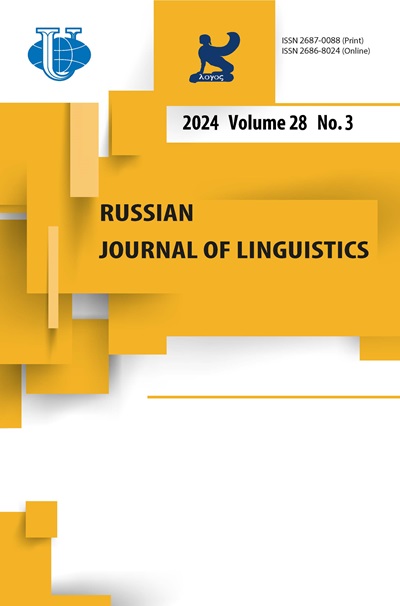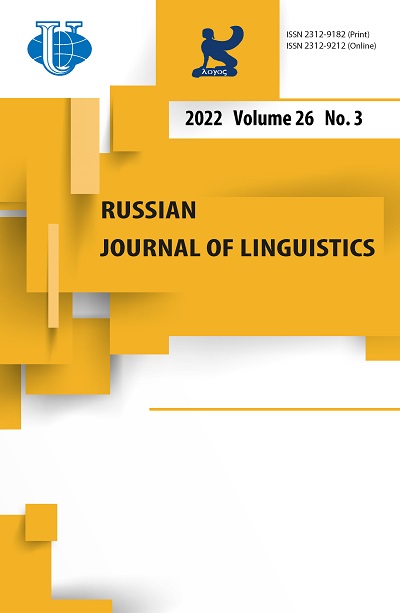Риторическая структура и средства убеждения в рекламных текстах: межкультурный анализ английской и арабской онлайн-рекламы
- Авторы: Хедри М.1, Хасан И.2, Критсис К.3
-
Учреждения:
- Сохарский университет
- Гарьянский университет
- Кипрский университет
- Выпуск: Том 26, № 3 (2022)
- Страницы: 596-624
- Раздел: Статьи
- URL: https://journals.rudn.ru/linguistics/article/view/32087
- DOI: https://doi.org/10.22363/2687-0088-24591
Цитировать
Полный текст
Аннотация
В наши дни большая часть интернет-торговли осуществляется с использованием английского языка. В то же время возникновение и рост арабской интернет-коммерции привлекает внимание таких гигантов интернет-торговли, как AliBaba и Amazon. В связи с этим возрастает потребность в более глубоком понимании культурно-специфических рекламных практик рекламодателями и маркетологами, стремящимися выйти как на англоязычные, так и арабоязычные потребительские рынки. Однако, работы, посвященные онлайн-рекламному дискурсу в определенных контекстах, немногочисленны. Настоящее исследование посвящено прагматическому двухуровневому риторическому анализу макроструктуры субжанра англоязычной и арабоязычной онлайн-рекламы. В центре внимания авторов - языковые средства убеждения, используемые как сигналы конститутивных ходов. Рассмотрение сравнительного корпуса 100 интернет-реклам продуктов для ухода за кожей, проведенное с опорой на модель риторического анализа ходов/ шагов (Swales), позволяет выделить новые слои риторической организации онлайн-рекламы. Результаты показывают, что в англоязычной и арабоязычной рекламе применяются как общие, так и культурно-специфичные риторические ходы. Стратегии убеждения в разной степени используют общие лексико-грамматические черты на синтаксическом, семантическом и дискурсивном уровнях. В целом, результаты анализа показывают, что онлайн-рекламу продуктов для ухода за кожей можно рассматривать как определенный субжанр с культурно-специфическими макро- и микроструктурами. Исследование специфических баз данных позволяет расширить аналитические подходы, используемые для анализа рекламного дискурса, и вносит вклад в межкультурное изучение риторической структуры и стратегий убеждения, используемых в онлайн-рекламе.
Ключевые слова
Об авторах
Мохсен Хедри
Сохарский университет
Автор, ответственный за переписку.
Email: mkhedri@su.edu.om
ORCID iD: 0000-0002-9286-4230
доцент факультета лингвистики
Сохар, ОманИтидал Хасан
Гарьянский университет
Email: eathasan@yahoo.com
старший преподаватель факультета искусств Гарьян, Ливия
Константинос Критсис
Кипрский университет
Email: kritsis.konstantinos@ucy.ac.cy
ORCID iD: 0000-0002-8011-2138
старший преподаватель кафедры английского языка
Никосия, КипрСписок литературы
- Ahangar, Abbas Ali & Seddigheh Zeynali Dastuyi. 2017. Persuasive language in the subgenre of Persian sales e-mails. Language & Communication 53. 69-86. http://dx.doi.org/10.1016/j.langcom.2016.08.010
- Al-Momani, Kawakib Radwan. 2014. Strategies of persuasion in letters of complaint in academic context: The case of Jordanian university students’ complaints. Discourse Studies 16 (6). 705-728. https://doi.org/10.1177%2F1461445614546257
- Arroyo, Belén López, Martín J Fernández Antolín & Rosario de Felipe Boto. 2007. Contrasting the rhetoric of abstracts in medical discourse. Implications and applications for English Spanish translation. Languages in Contrast 7 (1). 1-28. http://dx.doi.org/10.1075/lic.7.1.02lop
- Bhatia, Vijay Kumar. 1993. Analysing Genre: Language Use in Professional Settings. London: Longman.
- Bhatia, Vijay Kumar. 2004. Worlds of Written Discourse: A Genre-Based View. London: A&C Black.
- Biber, Douglas, Ulla Connor & Thomas Upton. 2007. Discourse on the Move: Using Corpus Analysis to Describe Discourse. Amsterdam: John Benjamins.
- Brett, Paul. 1994. A genre analysis of the results sections of sociology articles. English for Specific Purposes 13 (1). 47-59. https://doi.org/10.1016/0889-4906(94)90024-8
- Crawford Camiciottoli, Belinda. 2011. Ethics and ethos in financial reporting: Analyzing persuasive language in earnings calls. Business Communication Quarterly 74 (3). 298-312. https://doi.org/10.1177%2F1080569911413810
- Cheung, Ming. 2008. ‘Click Here’: The impact of new media on the encoding of persuasive messages in direct marketing. Discourse Studies 10 (2). 161-189. https://doi.org/10.1177%2F1461445607087007
- Cheung, Ming. 2010. The globalization and localization of persuasive marketing communication: A cross-linguistic socio-cultural analysis. Journal of Pragmatics 42 (2). 354-376. https://doi.org/10.1016/j.pragma.2009.06.012
- Cook, Guy. 2001. The Discourse of Advertising. London: Routledge.
- Connor, Ulla & Anna Mauranen. 1999. Linguistic analysis of grant proposals: European union research grants. English for Specific Purposes 18. 47-62. http://dx.doi.org/10.1016/S0889-4906(97)00026-4
- Cuddon, John Anthony. 2013. Dictionary of Literary Terms and Literary Theory. Oxford: John Wiley & Sons.
- Danesi, Marcel. 2015. Advertising Discourse. New York: John Wiley & Sons.
- del Saz-Rubio, M. Milagros. 2011. A pragmatic approach to the macro-structure and metadiscoursal features of research article introductions in the field of Agricultural Sciences. English for Specific Purposes 30 (4). 258-271. http://dx.doi.org/10.1016/j.esp.2011.03.002
- Díez-Fernández, Mercedes. 2009. English-Spanish Contrastive Analysis of Football Match Reports in Printed Press. From Description to Applications. PhD thesis. University of León, Spain.
- Dudley-Evans, Tony. 1994. Genre analysis: An approach for text analysis for ESP. In Malcolm Coulthard (ed.), Advances in written text analysis, 219-228. London: Routledge.
- Fairclough, Norman. 1989. Language and Power. London: Longman.
- Fairclough, Norman. 1992. Discourse and Social Change. Cambridge: Polity Press.
- Fuertes-Olivera, Pedro A., Marisol Velasco-Sacristán, Ascensión Arribas-Baño & Eva Samaniego-Fernández. 2001. Persuasion and advertising English: Metadiscourse in slogans and headlines. Journal of Pragmatics 33 (8). 1291-1307. http://dx.doi.org/10.1016/S0378-2166(01)80026-6
- Goering, Elizabeth, Ulla M. Connor, Ed Nagelhout & Richard Steinberg. 2011. Persuasion in fundraising letters: An interdisciplinary study. Nonprofit and Voluntary Sector Quarterly 40 (2). 228-246. https://doi.org/10.1177%2F0899764009339216
- Halliday, Michael, Alexander Kirkwood & Ruqaiya Hassan. 1976. Cohesion in English. London: Longman.
- Howe, Yuen Sen. 1995. A Genre-based Analysis of Car Advertisements in a Local Newspaper. PhD thesis. National University of Singapore, Singapore.
- Hunston, Susan & Geoff Thompson. 2000. Evaluation in Text: Authorial Stance and the Construction of Discourse. Oxford: Oxford University Press.
- Janoschka, Anja. 2004. Web Advertising: New Forms of Communication on the Internet. Philadelphia: John Benjamins.
- Kathpalia, Sujata Surinder. 1992. A Genre Analysis of Promotional Texts. PhD thesis. National University of Singapore, Singapore.
- Khedri, Mohsen & Konstantinos Kritsis. 2018. Metadiscourse in applied linguistics and chemistry research article introductions. Journal of Research in Applied Linguistics 9 (2). 47-73. https://dx.doi.org/10.22055/rals.2018.13793
- Labrador, Belén, Noelia Ramón, Héctor Alaiz-Moretón & Hugo Sanjurjo-González. 2014. Rhetorical structure and persuasive language in the subgenre of online advertisements. English for Specific Purposes 34. 38-47. http://dx.doi.org/10.1016/j.esp.2013.10.002
- Lapanská, Jana. 2006. The Language of Advertising with the Concentration on the Linguistic Means and the Analysis of Advertising Slogans. Diploma thesis. Komenskeho University, Bratislava, Slovakia.
- Larina, Tatiana, Vladimir Ozyumenko & Douglas Mark Ponton. 2020. Persuasion strategies in media discourse about Russia: Linguistic ambiguity and uncertainty. Lodz Papers in Pragmatics 15 (1). 3-22. https://doi.org/10.1515/lpp-2019-0002
- Larson, Mildred L. 1998. Meaning-Based Translation: A Guide to Cross-language Equivalence. University Press of America.
- Leech, Geoffrey. 1966. English in Advertising: A Linguistic Study of Advertising in Great Britain. London: Longmans.
- Martin, James R. & Peter R. White. 2005. The Language of Evaluation: Appraisal in English. Basingstoke, UK: Palgrave Macmillan.
- Martín, Pedro Martín. 2003. A genre analysis of English and Spanish research paper abstracts in experimental social sciences. English for Specific Purposes 22. 25-43. https://doi.org/10.1016/S0889-4906(01)00033-3
- Martín, Pedro Martín. 2005. The Rhetoric of the Abstract in English and Spanish Scientific Discourse: A Cross-Cultural Genre-Analytic Approach. Bern: Peter Lang.
- Mauranen, Anna. 1993. Contrastive ESP rhetoric: Metatext in Finnish-English economics texts. English for Specific Purposes 12. 3-22. https://doi.org/10.1016/0889-4906(93)90024-I
- Ozturk, Ismet. 2007. The textual organization of research article introductions in applied linguistics: Variability within a single discipline. English for Specific Purposes 26. 25-38. https://doi.org/10.1016/j.esp.2005.12.003
- Pilatova, Adella. 2015. The Language of Advertising: Analysis of Advertising Slogans in Fast Food Industry. PhD thesis. Masarykova University, Brno, Czech.
- Popova, Ksenia. 2018. Persuasion strategy in online social advertising. Training, Language and Culture 2 (2). 55-65. https://doi.org/10.29366/2018tlc.2.2.4
- Precht, Kristen. 2000. Patterns of Stance in English. PhD thesis. Northern Arizona University, Flagstaff, USA.
- Romanova, Irina & Irina Smirnova. 2019. Persuasive techniques in advertising. Training, Language and Culture 3 (2). 55-70. DOI: https://doi.org/10.29366/2019tlc.3.2.4
- Rush, Susan. 1998. The noun phrase in advertising English. Journal of Pragmatics 29. 155-171. https://doi.org/10.1016/S0378-2166(97)00053-2
- Sternkopf, Sylva-Michèle. 2005. English in Marketing: International Communication Strategies in Small and Medium-Sized Enterprises. Berlin: Frank & Timme.
- Suárez Tejerina, Lorena & Ana Isabel Moreno Fernández. 2008. The rhetorical structure of academic book review of literature. An English-Spanish cross-linguistic approach. In Ulla Connor, Ed Nagelhout & William Rozycki (eds.), Contrastive rhetoric. Reaching to intercultural rhetoric, 147-167. Amsterdam/Philadelphia: John Benjamins.
- Suchan, Jim. 2014. Toward an understanding of Arabic persuasion: A Western Perspective. International Journal of Business Communication 51 (3). 279-303. https://doi.org/10.1177%2F2329488414525401
- Swales, John. 1990. Genre Analysis: English in Academic and Research Settings. Cambridge: Cambridge University Press.
- Swales, John & Christine B. Feak. 2004. Academic Writing for Graduate Students: Essential Tasks and Skills. Ann Arbor, MI: University of Michigan Press.
- Tanaka, Keiko. 1999. Advertising Language: A Pragmatic Approach to Advertisements in Britain and Japan. London: Routledge.
- Upton, Thomas A & Ulla Connor. 2001. Using computerized corpus analysis to investigate the textlinguistic discourse moves of a genre. English for Specific Purposes 20. 313-329. http://dx.doi.org/10.1016/S0889-4906(00)00022-3
- Vergaro, Carla. 2004. Discourse strategies of Italian and English sales promotion letters. English for Specific Purposes 23 (2). 181-207. https://doi.org/10.1016/S0889-4906(03)00003-6
- Wales, Katie. 2001. A Dictionary of Stylistics. Harlow: Longman.
- Williams, Ian A. 2012. Cultural differences in academic discourse: Evidence from first-person verb use in the methods sections of medical research articles. In Stefania Marzo, Kris Heylen & Gert De Sutter (eds.), Corpus studies in contrastive linguistics, 63-88. Amsterdam/Philadelphia: John Benjamins.
- Zhu, Yunxia. 2001. Comparing English and Chinese persuasive strategies in trade fair invitations: A Sociocognitive Approach. Document Design 2 (1). 2-17. https://doi.org/10.1075/dd.2.1.02yun

















